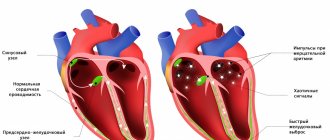Today, many people suffer from attacks of unreasonable panic fear. It can occur suddenly - in the subway, at home, among a crowd of people or completely alone, early in the morning or late at night. Such attacks are called “panic attack” or “vegetative crisis”. In fact, panic attacks and their symptoms are quite diverse, and can manifest differently in different people.
As a rule, at first there is a slight uneasy feeling. Anxiety increases in a matter of minutes - from fear a person cannot move: get up, go outside, go to work. The heart beats faster, the hands sweat, dizziness, headache, nausea, tremors occur, and the arms or legs may even become numb. It seems to a person that he is about to lose consciousness, go crazy, or even die from a heart attack or stroke, and therefore he is afraid to move, so as not to fall in front of many people or, conversely, to be left without help. And so, he can wait for 30-60 minutes until the attack of fear subsides.
“One day I was tinkering with my car in the garage as usual. Suddenly, out of the blue, I felt numbness on the left side of my face and body. I couldn't move, it was like I was paralyzed. At the same time, I began to feel very thirsty - my throat was dry. I felt hot and cold, and I just lay down in the car and waited for it to end. After 30 minutes I was released. From then on, as soon as I approached the car, I felt bad, and if I got behind the wheel, everything swam before my eyes. In the end, I even had to quit my job as a car mechanic,” patient Arthur (46 years old).
It also happens that a person who suddenly has a panic attack, on the contrary, runs as quickly as possible into fresh air because he experiences an acute feeling of suffocation - and this helps him cope with the attack.
Some patients complain that they begin to experience anxiety when faced with a specific situation. For example, when you need to drive or go to work. If a person continues an action that irritates his nervous system, the intensity of the attack increases. If he stops the action and returns home, then the anxiety gradually fades away. Thus, many people who suffer from panic attacks and their symptoms have to quit work, study, and completely change their usual lifestyle. And this method also often helps them to significantly reduce the manifestations of panic disorder, but not get rid of it completely. In addition, not everyone can afford such drastic changes in life.
What to do if you experience regular attacks of panic?
Panic attack symptoms
People with panic disorder very often do not see a doctor for a long time and do not tell their loved ones about the existing problem. As a rule, a person either thinks that there is no problem, and he himself will be able to cope with his poor health, forcibly overcoming all the signs of a panic attack, or he is embarrassed by his “weakness,” or is completely afraid that he will be “sent to a mental hospital.” This is completely unnecessary. However, it is necessary to treat sudden and regular panic fear.
“When I first had a panic attack, I had to call an ambulance. They just gave me glycine and didn't tell me anything else. After that, I went through the entire cardiology center and passed all the tests. I was told that I was absolutely healthy. My family and friends thought I was faking it. I tried not to pay attention to the attacks, reassuring myself that when I came home everything would be fine. Sometimes he deliberately drove himself into a traffic jam in order to overcome his fear. Such a nightmare was happening that you could at least abandon the car and leave. Sometimes I did just that. I would drop my car off at the metro station and come and pick it up the next day. Although before this illness I generally tolerated traffic jams calmly,” patient Pavel (41 years old).
First, let’s look at the symptoms with which you can probably come to the doctor and say: “Doctor, I’m having panic attacks. What to do?"
Psycho-emotional component of a panic attack. Symptoms and signs:
- Sudden, unreasonable attacks of fear/anxiety/panic, lasting from several minutes to several hours
- Waiting for sudden death, waiting for an attack
- Intrusive thoughts (usually related to death)
— Blurred consciousness
- Feeling of derealization (“I am separate, the world is separate”, “the world through cellophane”, “like in an aquarium”)
- Constant feeling of anxiety
— Various phobias (agoraphobia, social phobia, etc.)
— Insomnia, “nightmare” dreams
— Decreased mood, tearfulness
- Irritability, aggressiveness
“In the summer of 2014, I realized that I regularly could not fall asleep until 5-6 o’clock in the morning. The stuffy summer aggravated my condition, I constantly experienced a feeling of lack of air, my heartbeat quickened, obsessive thoughts arose in my head: “What if I’m dying?” - panic grew, but I had no strength to move or call an ambulance. I lay there like that until the morning, when my eyes closed on their own from fatigue and constant tension. This happened several times a week,” patient Elena (28 years old, manager).
Physiological component of a panic attack. Symptoms and signs:
— Dizziness, headache, heaviness in the head, noise in the head/tinnitus
- Lack of air, suffocation, shortness of breath
— Rapid heartbeat, feeling of interruptions in the heart, pain in the heart
- Nausea, abdominal discomfort
- Chills, fever, sweating
- Trembling in the arms, legs, body
- Muscle tension, numbness in limbs
— Gastrointestinal tract disorder
- Feeling tired, weak, lack of strength
“5 years ago I was unsuccessfully treated with antibiotics and after that I started having stomach problems. All these years I suffered from constant diarrhea. I contacted a parasitologist, gastroenterologist, immunologist and other specialists. Tests and clinical studies did not reveal any diseases. I tried to be treated with probiotics and prebiotics, but to no avail. Other symptoms also began to bother me: heaviness in the head, tension in the back and neck, anxiety for no reason, fear for one’s health, sometimes the heart was pounding wildly, in the morning after sleep there was slight dizziness and, of course, constant fatigue and weakness,” patient, Andrey (31 years old).
Important symptoms of panic attacks are also their systematicity and regularity. The interval between panic attacks can vary from a few minutes to several days or months, but their regular occurrence indicates that you are suffering from a panic disorder.
What to do in case of a sudden attack
If you feel the onset of a panic attack, you can prevent it using the following recommendations:
- in the first seconds, the gas balance provoked by hyperventilation should be normalized. To do this, you need to breathe into cupped palms or a paper bag;
- you need to close your eyes, relax, think about something good. It doesn’t hurt to lie down and at least take a nap;
- switch to the process that was affected by the crisis and continue to carry it out. On the street, you can start counting people passing by, solving arithmetic problems in your head, etc.;
- start singing your favorite song loudly – cheerful, energetic. The most suitable option is a children's room;
- surging heat and clouded consciousness can be cooled and cleared in the shower or by washing the face and skin behind the ears with cold water. Next, you need to look at yourself in the mirror and try to catch the moment the attack recedes;
- drink a cup of hot tea with honey and lemon balm - this soothing drink will calm you down and make you fall asleep;
- Massage your ears or palms - press the membrane between your thumb and index finger and hold it there for a count of five. Do this until the fear passes;
- chew chewing gum, which you should always have with you. The brain will switch, the numbness and excitement will go away. At this moment, you should start doing some distracting but pleasant things;
- Having auto-training skills, you can repeat to yourself - nothing bad happened, there is no danger, everything will pass very quickly.
Recommendation for those who are close to a person who is in crisis: do not be nervous, but take him by the hands and in a very calm voice convince him that everything is fine and will end well.
Panic attack. Emergency self-help.
First, learn how to manage your panic attacks yourself to control them and reduce the intensity of your panic attack symptoms.
Try practicing breathing techniques.
Breathe through your diaphragm (belly), in through your nose and out through your mouth slowly and calmly. For example, for 5 counts – inhale, for 10 – exhale.
“Some patients benefit from progressive muscle relaxation. If your muscles are very tense during a panic attack, try tightening your facial muscles: tense your jaw for 8 seconds - then relax, tense your lips for 8 seconds - relax. Repeat the exercise with your arms (palms, forearms) and switch to the next muscle group, for example, the calf muscles, the feet. Alternate tension and relaxation of all parts of the body will help relax the muscles and distract thoughts,” recommendations of a neurologist-vegetologist (“Clinical Center for Autonomic Neurology”).
During a panic attack, try to distract yourself and not think about the symptoms that are bothering you. Use psychological techniques. Visualize some place where you felt good: a house, a vacation spot, a cottage, a forest, a sandy beach - whatever your heart desires. And imagine in detail the entire environment that surrounds you there: a soft chair, a fluffy cat, the smell of pine trees, the crunch of branches under your feet, birdsong, warm sand, etc. Think in advance about where it would be better for you to “go” when you have another panic attack in order to distract your thoughts from its symptoms.
Keep a diary of panic attacks that you can refer to in critical situations. This way you can remind yourself that there is nothing to be afraid of, and the next panic attack will soon pass.
Types and causes of the disease
There are quite a lot of people in the world who are susceptible to panic attacks - up to 5% (most of them are women between 20 and 30 years old).
There are 3 types of panic attacks:
- spontaneous – sudden, appears without any obvious reason;
- situational - occurs in anticipation of a certain situation or directly during its course (before an exam, in anticipation of a conflict or directly during its course, etc.);
- conditional-situational - the impetus is a biological or chemical activator (change in hormonal levels, ingestion of alcoholic beverages, drugs, alcohol.
The following factors contribute to the occurrence of panic attacks:
- Genetic predisposition, that is, the disorder is transmitted with genes. In this case, it will be very difficult to cope with it and will take a long time.
- The presence of phobias, that is, fear of something.
- Poor monotonous diet, lack of vitamin B in the body.
- Significant event (wedding, birth of a child, death of a loved one, etc.)
- Certain diseases, inflammatory processes, hypoglycemia (low blood sugar), hyperthyroidism (activation of thyroid function), post-traumatic syndrome.
- Self-doubt, personal problems, failures in life.
- Having bad habits.
- Wrong lifestyle.
- Internal conflict.
- Depression.
- Taking strong antibiotics that have multiple side effects or are addictive.
- Withdrawal syndrome – refusal of alcohol. Such “withdrawal” often leads to nervous breakdowns and excessive anxiety.
- Hyperventilation syndrome from the habit of breathing deeply - this disrupts the balance of carbon and oxygen, which leads to the consequences mentioned above.
- Taking stimulants or narcotics, caffeine, antidepressants, or medications the simultaneous use of which is undesirable.
- Serious cardiovascular diseases that can lead to death. The person realizes this and at the slightest deterioration of the condition begins to panic.
- Consequences of very high physical or sports activities.
- Hormonal changes in the female body - pregnancy, before menstruation, menopause.
Panic attacks. Difficulties in diagnosis.
People suffering from the symptoms of panic attacks usually do not know where to turn. They visit the offices of a therapist, cardiologist, endocrinologist, psychiatrist, psychologist, but doctors do not detect any disturbances in the functioning of the body. Of course, it is advisable to undergo all possible examinations and pass all the necessary tests in order to exclude the development of serious physiological abnormalities. However, if, in the end, they tell you that you are absolutely healthy, but anxiety, tachycardia, insomnia and other symptoms continue to torment you, then most likely you suffer from panic disorder, which means the problem lies in a disruption of the autonomic nervous system , which can only be identified by an experienced neurologist-vegetologist.
Some patients with signs of panic attacks are diagnosed with vegetative-vascular dystonia (VSD) and told that they will have to live with such symptoms all their lives, alleviating them with medications: antidepressants and tranquilizers.
“I went to all the doctors because there were a lot of symptoms: my heart, shortness of breath, blood pressure, my stomach, bones, muscles ached, I felt constant anxiety. At first, rare panic attacks grew into a daily norm. The neurologist prescribed Coaxil, but the pills made me feel worse. I drank Coaxil for three months and barely got off it. Then the therapist prescribed me adaptol. It made me feel better, but only while I was drinking it, and as soon as I stopped drinking, everything started all over again. Everything was useless until I learned from friends about the “Clinical Center for Autonomic Neurology”,” patient, Arthur (46 years old).
The deep misconception that VSD and panic attacks cannot be treated can be dispelled if you visit a doctor who specializes specifically in disorders of the autonomic nervous system. Panic attacks can be treated and diagnosed! The main thing is to know where and how this can be done.
Panic attacks. Modern diagnostic methods.
Only a qualified neurologist-vegetologist can diagnose panic disorder, which manifests itself as panic attacks, identify its symptoms and prescribe optimal treatment.
At the initial examination, the vegetarian doctor must examine the patient’s normal reflexes, his muscular system, sensory organs, cognitive functions (memory, speech, perception), assess the general psycho-emotional state of the patient, taking into account all his complaints in order to collect a complete picture of the disease.
Next, there are several methods for diagnosing autonomic nervous disorder. One of them is the study of heart rate variability.
The patient performs a simple load: first he lies on his back, and after a few minutes he gets to his feet. In this way, we simulate a standard everyday situation when the minimum load is placed on our body. During this time, sensors attached to the patient's chest record the rhythm of his heart, and the doctor then compares the changes in rhythm in both positions. Such a study shows how adapted the human body is to the usual minimum load, which our autonomic nervous system normally copes with every day without the slightest difficulty.
How it works?
In a healthy state, our body responds adequately to any “stress”, any load (mental, physical, emotional). Therefore, when a healthy person gets up, the sympathetic part of the autonomic nervous system is activated in his body and the hormone adrenaline is produced, which means the heartbeat quickens. When a person lies down, his body should normally be in the mood for rest and relaxation. At the physiological level, this manifests itself as follows: the parasympathetic department of the autonomic nervous system becomes active and the hormone acetylcholine is released, which extinguishes the activity of adrenaline, and a phase of relaxation and replenishment of the body’s reserves begins.
But in patients with symptoms of panic attacks, an abnormal change in heart rhythms is observed: that is, when a person lies down, his pulse quickens and becomes faster and faster. That is, when a person gives his body the command to tune in to rest, the body understands the opposite - and prepares to run a short distance race. This is why people with disorders of the autonomic nervous system so often cannot sleep at night and never feel rested and alert.
Thus, the doctor concludes that the harmonious functioning of the sympathetic and parasympathetic parts of the nervous system is disrupted. This means you can move on to the next stage of the examination.
Among the innovative methods for diagnosing panic disorder are studies of the autonomic nervous system using infrared thermography. In an infrared image, a thermal imager clearly shows in which nodes (ganglia) of the autonomic nervous system the work is disrupted. It is with these vegetative nodes that the neurologist-vegetologist will subsequently work.
“Serious scientific research over the last decade has shown the high reliability and reliability of thermography. This allows this method to be used in medical practice to make a diagnosis in complex cases,” James Mercer, Professor, President of the European Thermography Society (EAT).
| Fig. 1 – Thermal image before treatment of panic attacks and VSD – the functioning of the vegetative node in the cervical region is disrupted (colors – red and orange) | Fig. 2 - Thermal image of the same patient after treatment of panic attacks and VSD - the temperature in the vegetative node of the cervical spine has returned to normal (colors - blue and green) |
After treatment, you can take a repeat infrared photo, in which you will notice progress from the completed course. Areas with abnormal temperatures (bright red or dark blue) will change color in the image because their temperature regime is closer to normal.
PsyAndNeuro.ru
We present to your attention a review translation of clinical recommendations for the treatment of panic disorder of the American Psychiatric Association, prepared jointly by the scientific Internet portal “Psychiatry & Neuroscience” and the Clinic of Psychiatry and Addiction Medicine Doctor SAN.
Panic disorder or episodic paroxysmal anxiety is a mental disorder characterized by the spontaneous occurrence of panic attacks from several times a year to several times a day and the anticipation of their occurrence, which are accompanied by certain neurovegetative symptoms. A characteristic feature of the disorder is recurrent attacks of severe anxiety (panic), which are not limited to a specific situation or circumstances and, therefore, are unpredictable.
Create a therapeutic alliance
- Be sensitive to the patient's wishes and concerns regarding treatment.
- Explain panic disorder in language the patient can understand.
- Support the patient during phases of treatment that may increase anxiety (eg anticipating side effects of medications, immersion in agoraphobic situations).
Assess the patient's condition
- Assess features of the clinical picture that may influence the treatment plan, including agoraphobia, degree of situational fear and avoidance behavior; presence of psychiatric comorbidities, including substance abuse; presence of physical health problems.
- It is necessary to determine whether panic attacks are a symptom of panic disorder or are associated with substance use, medical illness (eg thyroid disease), or side effects of medications (eg oral corticosteroids).
- It should be kept in mind that panic disorder can co-occur with many physical and mental illnesses, in particular personality disorders, substance abuse and mood disorders.
EXAMINATION OF A PATIENT WITH PANIC DISORDER
- Medical history and current condition
- Mental problems in the past
- History of non-psychiatric illnesses
- History of substance use, including illicit substances, prescription and over-the-counter medications, and other substances (eg caffeine) that may produce physiological effects and exacerbate panic symptoms
- Biography (eg key events in life)
- Social, occupational (including military service) and family history
- Medicines taken
- Previously practiced treatment
- Overview of body systems
- Mental status assessment
- Physical examination
- Appropriate diagnostic tests to identify possible causes of panic symptoms
SOMATIC DISEASES THAT OCCUR IN PANIC DISORDER MORE FREQUENTLY THAN IN THE GENERAL POPULATION
- Thyroid diseases
- Cancer
- Chronic pain
- Heart diseases
- Irritable bowel syndrome
- Migraine
- Mitral valve prolapse
- Vestibular disorders
- Allergic conditions
- Respiratory diseases
Create an individual treatment plan
- Consider the nature of symptoms, frequency of symptoms, reasons for their occurrence and associated conditions.
- To better assess symptoms, you can ask the patient to keep a diary. A diary will help assess changes in mental status and response to treatment.
- Consider the patient's nationality and cultural background when developing a treatment plan.
Assess patient safety
- Be careful when assessing your risk of suicide. Panic disorder is associated with an increased risk of suicidal ideation and suicide attempts, even in the absence of comorbid conditions such as depression.
- Decide whether the patient's safety requires hospital treatment.
ASSESSMENT OF THE RISK OF SUICIDE IN PATIENTS WITH PANIC DISORDER
- Identify specific psychiatric symptoms that are associated with suicide attempts
- Collect information about past suicide attempts, suicide and mental health of relatives, as well as current sources of stress
- Assess protective factors – reasons to continue living
- Ask about suicidal thoughts, intentions, plans, methods of committing suicide, preparation for suicide
Assess the type and extent of functional impairment
- It is necessary to find out how panic disorder harms the patient in such areas of life as work, study, family, social relationships, and leisure.
- The goal of treatment should be to minimize impairment in these areas of life.
Determine treatment goals
- Reduce the frequency and severity of panic attacks, anticipatory anxiety, agoraphobic avoidance, achieve complete remission of symptoms and return to the level of functioning that was before the illness.
- Treat co-occurring mental disorders, if present.
Monitor the patient's mental status
- Monitor any symptoms that were initially present in the patient.
- It is important to understand that symptoms may go away in stages (eg panic attacks may stop before agoraphobic avoidance stops) and that new symptoms may appear over time.
- To facilitate the assessment of the patient's condition, a scoring system can be used.
Educate the patient and, in certain cases, family members
- Tell the patient about the disease and treatment.
- Inform the patient that panic attacks are not life-threatening, are almost never harmful, are not unusual, and will subside over time. This information alone can reduce symptoms.
- The patient should be encouraged to read educational literature, brochures and websites with reliable information.
- In certain cases, family members need to be trained. You can discuss with them how the patient's condition will affect the family's life, and how relatives can help or hinder treatment.
- Encourage the patient to maintain a healthy lifestyle: exercise, sleep hygiene, and reducing consumption of caffeine, tobacco, alcohol, and other potentially harmful substances.
Coordinate your work with other doctors
- Maintain communication with other professionals treating the patient.
- Ensure that the patient's physical health has been assessed (by a psychiatrist or other specialist) to rule out physical causes of panic symptoms. Extensive and specialized examination for physical causes of panic attacks is usually not indicated, but can be carried out based on the individual characteristics of the patient.
Ensure patient adherence to treatment
- If possible, find out what may reduce the patient's adherence to treatment and work with the patient to minimize the impact of these factors.
- Encourage the patient to articulate his fears related to treatment.
- Explain to the patient when to expect improvement to prevent premature cessation of treatment.
FACTORS WEAKENING COMMITMENT TO TREATMENT
- Avoidance behavior as a manifestation of panic disorder
- Logistical obstacles (eg economic factors, travel difficulties, child care)
- Cultural or language barriers
- Problems communicating with a doctor
- A short-term exacerbation of anxiety associated with treatment (eg due to side effects of medications or exposure to something that triggers fear)
Work through the issue of possible relapse with the patient
- Reassure the patient that symptoms may vary until remission occurs.
- Once remission occurs, provide the patient with a plan for dealing with symptoms that may persist or recur.
Decide where the treatment will take place
- Treatment is usually carried out on an outpatient basis.
- In some situations, hospitalization is necessary, such as high risk for suicide or substance intoxication, to treat severe panic disorder with agoraphobia when outpatient treatment is not effective or feasible.
- Home visiting is an option for working with patients with severe agoraphobia who have difficulty leaving the house.
- In cases where access to mental health care is difficult (eg in remote areas), telephone or Internet-based treatment may be considered.
Choose a treatment method
- The effectiveness of antidepressants (SSRIs, SSRIs, TCAs) or cognitive behavioral psychotherapy (CBT) as the initial treatment of panic disorder has been proven in many randomized controlled trials. If there is no associated mood disorder, benzodiazepine monotherapy can be used as initial treatment.
- One type of psychodynamic psychotherapy, panic-focused psychodynamic psychotherapy (PAPP), has been shown to be effective in one randomized controlled trial and can be used as initial therapy.
- There is no basis to recommend one pharmacological or psychosocial approach as superior to another, or to recommend combination treatment over monotherapy, although combinations may be helpful in certain cases.
- If a pregnant woman, breastfeeding or planning a pregnancy has panic disorder, psychosocial interventions should be used instead of pharmacotherapy. Pharmacotherapy can be used, but its benefits and risks should be discussed with the patient, her gynecologist and, if possible, her partner. When discussing this topic, one should raise the issue of the possible risks that untreated panic disorder and concomitant mental disorders pose to the patient and her child.
FACTORS TO BE CONSIDERED WHEN CHOOSING INITIAL TREATMENT
General factors
- Patient Preferences
- Risks and benefits of treatment, including the risk of side effects from medications
- Patient treatment history
- Presence of concomitant somatic and mental illnesses
- Cost of treatment
- Availability of treatment
Factors in favor of psychosocial treatment
- The patient prefers non-drug treatment
- The patient is willing to spend time and effort on this type of treatment
- The patient is a pregnant woman, breastfeeding or planning pregnancy
- The patient has a comorbid personality disorder
Factors in favor of pharmacotherapy
- The patient prefers drug treatment
- The patient does not have the time and other resources needed for psychosocial treatment
Factors in favor of combination treatment
- Standard monotherapy did not work
- The patient wants immediate relief (with pharmacotherapy)
- The patient wants to reduce the need for medications in the future
Factors to consider when choosing pharmacotherapy
- For many patients with panic disorder, SSRIs or SSRIs are the best choice due to their comparatively better safety and fewer side effects.
- Although TCAs are effective, their side effects and toxicity at high doses often limit their use.
- For patients with comorbid depression or substance abuse, SSRIs, SSRIs, and TCAs are superior to benzodiazepines as monotherapy. Benzodiazepines may be especially useful as an adjunct to antidepressants to treat remaining symptoms of anxiety. Benzodiazepines are preferred (as monotherapy or in combination with antidepressants) in cases where symptoms cause very severe discomfort and deterioration, and the patient critically needs early control of symptoms. The benefits of rapid-acting benzodiazepines must be weighed against the potential for unwanted side effects (eg sedation) and physiological dependence, which may make benzodiazepines difficult to discontinue.
- MAOIs are effective for panic disorder, but for safety reasons they are prescribed when several first-line treatments have failed.
- Other drugs with weaker evidence base (eg mirtazapine, anticonvulsants such as gabapentin) may be considered as a monotherapy option or as an addition to primary therapy in special cases or when several standard approaches have failed.
FACTORS TO BE CONSIDERED WHEN CHOOSING A DRUG FOR THE TREATMENT OF PANIC DISORDER
- Side effects
- Price
- Pharmacological properties
- Potential interaction with other medications
- Patient treatment history
- Concomitant somatic and mental illnesses
- Strength of the evidence base for the use of a particular drug
Factors to consider when choosing psychotherapy
- CBT is recommended and its effectiveness for panic disorder has been confirmed by multiple randomized controlled trials. The effectiveness of group CBT has been supported by multiple controlled studies. The effectiveness of self-administered CBT has been supported by several controlled studies.
- Exposure therapy is also recommended.
- The effectiveness of COPP has been confirmed by one randomized controlled trial. Evidence of the effectiveness of psychodynamic psychotherapy for panic disorder is limited to case reports and the experience of experts in the field of psychodynamic psychotherapy.
- Other psychosocial interventions have not been formally tested for panic disorder, or have been shown to be ineffective (eg eye movement desensitization and reprocessing) or to be less effective (eg supportive psychotherapy) than standard therapy such as CBT.
- Other types of group psychotherapy (including patient support groups) are not recommended as monotherapy for panic disorder but may be effective adjunctive treatments for some patients.
- Couples or family therapy is not recommended for treating panic disorder, although it may be helpful in addressing relationship problems that arise.
FACTORS TO BE CONSIDERED WHEN CHOOSING PSYCHOTHERAPY FOR THE TREATMENT OF PANIC DISORDER
- Patient Preferences
- Cost and Availability
- Treatment history
- Strength of the evidence base for the use of a particular type of psychotherapy
- Presence of comorbid personality disorder
Stabilize the medication dose
- Patients with panic disorder may be sensitive to side effects, so it is recommended that SSRIs, SSRIs, and TCAs be started at low doses (approximately half the initial dose prescribed for patients with depression). After a few days of use, the initial dose should be gradually increased to a therapeutic dose, if there are no problems with tolerability of the drug.
- Antidepressant underdosing (i.e., starting treatment at a low dose without subsequently increasing to a therapeutic dose) is a common occurrence in the treatment of panic disorder and often results in incomplete response to treatment or no response.
- If benzodiazepines are prescribed, it is preferable for patients with panic disorder to take them on a scheduled basis rather than on an as-needed basis. The goal is not to relieve symptoms once a panic attack has begun, but to prevent a panic attack.
- Once medications are started, patients are typically seen every 1 to 2 weeks, then every 2 to 4 weeks until the dose is stabilized. Once the dose has stabilized and symptoms have subsided, the occurrence may be less frequent.
DOSE OF ANTIDEPRESSANTS AND BENZODIAZEPINES FOR PANIC DISORDER
| Initial dose and dose escalation steps (mg/day) | Therapeutic dosea | |
| SSRIs | ||
| Citalopram | 10 | 20-40 |
| Escitalopram | 5-10 | 10-20 |
| Fluoxetine | 5-10 | 20-40 |
| Fluvoxamine | 25-50 | 100-200 |
| Paroxetine | 10 | 20-40 |
| Paroxetine controlled release | 12,5 | 25-50 |
| Sertraline | 25 | 100-200 |
| SSRI | ||
| Duloxetine | 20-30 | 60-120 |
| Venlafaxine extended release | 37,5 | 150-225 |
| TCA | ||
| Imipramine | 10 | 100-300 |
| Clomipramine | 10-25 | 50-150 |
| Desipramine | 25-50 | 100-200 |
| Nortriptyline | 25 | 50-150 |
| Benzodiazepines | ||
| Alprazolam | 0.75-1.0b | 2-4b |
| Clonazepam | 0.5-1.0c | 1-2c |
| Lorazepam | 1.5-2.0b | 4-8b |
aHigher doses are used when the patient does not respond to the usual therapeutic dose.
b Usually divided into 3-4 doses during the day.
c Often divided into 2 doses throughout the day.
SAFETY IN PHARMACOTHERAPY FOR PANIC DISORDER
| Drugs | Dangers | Recommendations |
| SSRIs | Suicidal ideation and suicide attempts | Monitor for thoughts of self-harm or suicide, as well as for side effects (eg anxiety, agitation, insomnia, irritability) that may prompt such actions. |
| Upper gastrointestinal bleeding | Be aware of the increased risk, especially when SSRIs are taken together with non-steroidal anti-inflammatory drugs or aspirin. | |
| Falls and fractures | Use with caution when treating elderly patients. | |
| SSRI | Suicidal ideation and suicide attempts | See SSRIs. |
| Venlafaxine extended release | Stable hypertension in a small proportion of patients | Monitor blood pressure, especially when increasing the dose. |
| TCA | Suicidal ideation and suicide attempts | See SSRIs. |
| Anticholinergic effects | Do not prescribe TCAs to patients with worsening narrow-angle glaucoma or clinically significant prostatic hypertrophy. | |
| Falls and fractures | See SSRIs. | |
| Significant or fatal arrhythmia | Patients with cardiac conduction disorders should have an ECG before starting treatment. | |
| Significant cardiotoxicity and death in overdose | Use with caution in patients with suicidal tendencies. | |
| Benzodiazepines | Sedation, fatigue, ataxia, slurred speech, memory impairment, weakness | |
| Falls and fractures | See SSRIs. | |
| Increased risk of car accidents | Warn the patient about the risks associated with driving a car and operating complex devices. | |
| Additive effect when combined with alcohol | Inform the patient of these effects, particularly the combination of sedation and respiratory depression. | |
| Potential abuse or relapse of substance abuse disorders | Prescribe with caution to patients with a history of substance abuse disorders, and also carefully monitor, eg dispense the drug in limited quantities, monitor intake, monitor adherence to treatment, increase the frequency of appointments. | |
| Cognitive impairment | Monitor for the development of cognitive impairment, which may become a problem at high doses and in patients performing complex information-processing tasks at work. Use with caution in elderly patients and those who already have cognitive impairment. |
Ensure that psychosocial interventions are carried out by professionals with appropriate training and experience
- CBT for panic disorder typically involves teaching self-help, self-control, challenging anxious attitudes, confronting fear triggers, changing anxiety-maintaining behaviors, and preventing relapse. The clinician may emphasize specific points depending on the patient's symptoms and response to various CBT techniques. For most patients, exposure to fear-provoking situations requires the most effort, but is often the most powerful component of CBT.
- Exposure therapy focuses almost exclusively on systematic immersion in fear-provoking situations.
- Possible benefits of group CBT include: relief from shame and stigma; the ability to plan, use sources of inspiration and support; Exposure therapy for those who experience panic symptoms in a social situation.
- COPP uses the basic principles of psychodynamic psychotherapy with an emphasis on transformation, which occurs under the influence of a therapeutic agent that promotes change by encouraging patients to reduce the emotional significance of panic symptoms to gain greater autonomy, relieve symptoms and improve functionality.
- Other types of psychodynamic psychotherapy may focus on broader emotional and interpersonal issues.
Provide psychosocial support for an appropriate period of time and in an appropriate format
- CBT usually lasts 10-15 weeks.
- Self-guided CBT is suitable for those patients who do not have access to a CBT specialist.
- During the efficacy studies, COPN was administered for 12 weeks twice a week.
Evaluate whether your chosen treatment plan is working
- The effect of treatment is manifested in the weakening of the main symptoms: the frequency and strength of panic attacks, the level of anticipation anxiety, the degree of agoraphobic avoidance, and the discomfort caused by panic disorder.
- In some areas, success may be achieved more quickly (eg, the frequency of panic attacks may decrease before the degree of agoraphobic avoidance decreases). The nature of the weakening of symptoms depends on the individual characteristics of the patient; for example, for some people relief occurs quickly and immediately, for others the condition improves gradually and slowly over several weeks.
If the response to initial treatment is unsatisfactory, the first step is to determine the reasons
- If, as a result of panic disorder, the patient has come to terms with the consequences of avoidant behavior and accepted functional limitations, then the patient should be encouraged to compare the benefits of such acceptance with the benefits of treatment.
- The physician should strive to achieve remission as far as possible and not be satisfied with partial improvement.
If response to initial treatment remains unsatisfactory, add another first-line agent or change treatment
- Decisions about how to proceed in treatment-resistant cases are individualized and made based on clinical experience, since the effect of changing drugs or augmentation has been poorly studied.
- If initial treatment has produced visible results, it is reasonable to resort to augmentation. For example, you can add another drug (eg a benzodiazepine to an antidepressant) or combine pharmacotherapy with psychotherapy.
- If initial treatment does not bring visible improvement, it is best to change your treatment plan.
- If treatments with the strongest evidence base do not lead to success (due to lack of effect or due to severe side effects), methods with less strong evidence should be considered (eg MAOIs, DOACs).
- Once first- and second-line methods and augmentation have been used, the methods with the weakest evidence of effectiveness can be moved on. These include monotherapy or augmentation with gabapentin, second-generation antipsychotics, or other types of psychotherapy (not CBT or COPP).
If severe symptoms persist despite long-term treatment, a new treatment plan should be made and advice from another professional should be made.
CLINICAL FACTORS RESPONSIBLE FOR UNSATISFACTORY TREATMENT RESPONSE
- Untreated somatic disease
- Impact of comorbid physical or mental illness (including depression and substance abuse)
- Lack of adherence to treatment
- Problems with creating a therapeutic alliance
- Psychosocial stressors
- Problems with motivation
- Drug intolerance
After response to treatment, provide maintenance therapy to further reduce symptoms and prevent relapse
- Pharmacotherapy should last a year or more. Research suggests that the therapeutic effects of antidepressants last as long as they are taken. Clinical experience suggests that many patients can take benzodiazepines for many years without a return of symptoms.
- For those undergoing psychotherapy, supportive psychotherapy may be helpful in maintaining gains; however, further research is required on this issue.
- The decision to discontinue pharmacotherapy should be made jointly with the patient.
- The discussion should address the possible consequences of stopping pharmacotherapy, including relapse of symptoms and withdrawal syndrome.
There are several factors to consider before stopping pharmacotherapy:
- Patient's level of motivation
- Duration of remission achieved
- Accompanying illnesses
- Current and upcoming psychosocial stressors
- Psychological support
- Availability of alternative treatments
When discontinuing medications, you should gradually reduce the dose (i.e., reduce over several weeks or months), observe for relapse and, if necessary, return to the effective dose of the drug
- SSRIs, SSRIs, TCAs can be reduced by one step every month or every two months. In emergency cases (eg pregnancy or a situation in which it is decided to stop taking the medication immediately), the dose can be reduced more quickly.
- Withdrawal syndrome and relapse of symptoms typical of stopping benzodiazepines may occur during dose reduction and become particularly severe towards the end of the dose reduction. For this reason, benzodiazepines should be tapered off very slowly, over 2-4 months, with a reduction of no more than 10% each week. CBT may be used to alleviate withdrawal symptoms.
Panic attacks symptoms and treatment
To successfully treat panic attacks, an integrated approach is required; one of the modern treatment methods is complex physiotherapy. The treatment is aimed at the root cause of the disorder, which is rooted in the physiological disruption of the body. Psychotherapy can also be used as a method of treating panic attacks, but only as an auxiliary link. In some cases, a psychotherapist can alleviate the condition and reduce the severity of panic neurosis.
One of the clinics in Moscow that specializes directly in disorders of the autonomic nervous system is the Clinical Center for Autonomic Neurology. The clinic’s doctors have extensive experience working with panic attacks: they know how their symptoms manifest themselves and what treatment will be optimal in a given case. As part of a comprehensive physiotherapy course, you can be offered:
— undergo a course of intravenous laser therapy
— infrared laser therapy
— magnetic therapy
— as well as a course of color pulse correction of suprasegmental autonomic disorders (color therapy)
All methods are aimed at working directly with damaged vegetative nodes.
The targeted effect on the nerve nodes in its effect on the body is reminiscent of acupuncture in oriental medicine (acupuncture), but the action of the laser is much more accurate and is based on science, and not on ancient intuitions, especially since it is supported by thermal imaging images that show the localization of the vegetative node in the human body accurate to the millimeter.
“I underwent 2 courses of acupuncture with symptoms of panic attacks. After the first course, which lasted a month, I felt better - I just sighed. But a month later I had to return. Another month after the second course, my body completely returned to its previous deplorable state. The effect faded away again. Acupuncture gave me only temporary relief. The effect of the laser was incomparably more effective,” patient Alexander (43 years old).
For most patients, it is enough to undergo one course of comprehensive physical therapy to feel significantly better, and after a recovery period that lasts from 4 to 6 months, to completely get rid of all symptoms of panic attacks. In more advanced cases, several courses may be required. However, noticeable improvements are noticeable after the first treatment session.
“During laser therapy sessions, I felt relaxed and even fell asleep. After the first sessions, the anxiety noticeably subsided and my head cleared. Panic attacks after completing the course of treatment became rare and short-lived. There was one case of exacerbation in the subway, but the doctor warned me that this was possible during the recovery period. I happily completed the second course of treatment a year later and now I feel even better than when I didn’t have panic attacks yet,” patient Sergei (34 years old).









